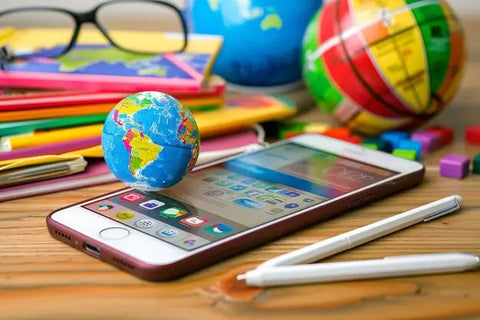In today's world, technology is changing faster than ever, and this is especially true in education. In recent years, new tools and devices have come into classrooms, making it easier for teachers to teach and students to learn. Things like interactive whiteboards, learning apps, and online platforms are now a big part of how schools work.
Teachers, students, and parents need to understand these changes in education. Staying up-to-date with the latest tech trends can make learning more fun, help students do better in school, and prepare them for the future. For schools and teachers, knowing about these new tools helps them use the best resources to support their students’ success.
1. The Rise of Artificial Intelligence in Education

Artificial Intelligence (AI) is changing education by making learning more tailored and effective for students. One of the most exciting ways AI is being used is through personalized learning.
Personalized Learning
AI can help create a unique learning experience for each student by analyzing how well they perform on different tasks. This process is known as adaptive learning. For example, if a student is struggling with math, AI algorithms can adjust the lessons to focus more on those areas where they need help. This way, the learning material is tailored specifically to each student’s needs, helping them improve where it matters most.
Another advantage of AI is that it can develop customized learning paths for students. This means that AI can identify a student's strengths and weaknesses and create a learning plan that suits them perfectly. This personalized approach allows students to learn at their own pace, ensuring they fully understand each topic before moving on to the next.
AI Tutors and Assistants
AI is also being used to create tools like AI tutors and virtual assistants that can help students outside of the classroom. For instance, some virtual tutors can answer questions, explain difficult concepts, and provide practice problems. Some AI tools even use chatbots, which are programs that can talk with students in real-time, giving them instant feedback and guidance.
AI tools are helpful because they are available all the time and give quick answers, but they also have some drawbacks. They can’t replace the personal support and encouragement from a teacher, and students might rely too much on technology, which could hurt their ability to learn on their own.
2. Gamification and Interactive Learning

Gamification and interactive learning are making lessons more fun and effective, changing how students get involved in their education.
Educational Games
Educators are increasing student engagement by adding game elements to their lessons, a method called gamification. This makes learning feel like a game, which can make students more motivated and involved. For example, students might earn points, badges, or levels for completing tasks or learning new skills. These game-like features help students stay motivated, even when the material is tough, because it makes learning more fun and rewarding.
There are lots of successful educational games for different subjects and ages. For example, games like Kahoot! and Quizlet make studying more fun and competitive, helping students remember information better. In math, Prodigy uses games to help students practice skills while having fun. These games make learning enjoyable and encourage students to take part more in their education.
Interactive Simulations
Another powerful tool in modern education is interactive simulation. Many educational games work well for different subjects and ages. For example, games like Kahoot! and Quizlet make studying fun and competitive, helping students remember information better. In math, Prodigy uses games to let students practice skills while having fun. These games make learning enjoyable and encourage students to be more involved in their education.
The benefits of using simulations in the classroom are clear. They help students see and experience ideas that might be tough to grasp with regular teaching. For example, instead of just reading about the solar system, students can explore it in a virtual space and watch the planets move. This makes learning more engaging and helps students understand the topic better.
3. Virtual and Augmented Reality (VR/AR)

Virtual Reality (VR) and Augmented Reality (AR) are revolutionizing the way students learn by creating immersive and interactive experiences that bring education to life.
Immersive Learning Experiences
Virtual Reality lets students explore new worlds without leaving the classroom. With VR headsets, students can experience historical events, scientific discoveries, or art in a fun and immersive way. Many schools are already using VR to make learning more exciting. This makes learning more engaging and helps students remember what they learn better.
Enhanced Visualizations
Augmented Reality (AR) makes learning more exciting by adding digital images to the real world. For example, if you're reading about the solar system, AR can show the planets spinning around the sun on your page. This makes learning more interactive and interesting.
Augmented Reality (AR) greatly helps students learn by making complex ideas easier to understand. For example, in a biology class, AR can show a 3D model of a cell, letting students look at and explore its parts up close. This interactive method helps students grasp tough topics better because they can see and engage with what they’re studying in real time.
4. Mobile Learning and Educational Apps

Mobile learning is a big trend in education, letting students learn anytime and anywhere. With the rise of smartphones and tablets, learning on the go has never been easier.
Learning on the Go
One of the biggest advantages of mobile learning is its flexibility. Students can now access educational content from their devices whenever they have time, whether they’re on the bus, at home, or even on vacation. This makes it easier for students to fit learning into their busy schedules and keep up with their studies outside of the classroom.
There are countless educational apps available that cater to different subjects and age groups. For example, apps like Duolingo help students learn new languages, while Khan Academy offers lessons in math, science, and more. These apps make learning fun and interactive, letting students explore new topics and practice what they’ve learned in school right from their phones.
Accessibility and Inclusivity
Another important benefit of mobile learning is that it can support diverse learning needs. Mobile learning tools are made to match different ways students learn, especially those who find traditional methods hard. Some apps help students with disabilities, making learning easier for everyone.
Yet, mobile learning does come with challenges, such as unequal access to technology. Not all students have the same access to smartphones, tablets, or reliable internet, which can make learning harder. To solve this problem, schools and communities are working on solutions. They are giving devices to students who need them and offering ways to learn offline, so everyone can enjoy mobile learning.
5. Cloud-Based Learning Platforms

Cloud-based learning platforms are changing the way students and teachers interact, making education more collaborative and accessible than ever before.
Collaboration and Accessibility
Cloud-based platforms offer great benefits for students and teachers because they let people work together in real-time from anywhere. This means students can work on group projects even if they're in different places, and teachers can give feedback right away. These platforms help everyone stay connected and make learning more interactive and exciting.
Data Management and Security
With so much information being stored online, it’s crucial to protect student data. These platforms handle things like grades, assignments, and personal details. To keep this information safe, you should:
- Use strong passwords that are hard to guess.
- Turn on two-factor authentication, which adds an extra layer of security.
- Update your software regularly to protect against new threats.
6. EdTech Integration in the Classroom

EdTech, or educational technology, is changing how teachers teach and students learn. It mixes old-school methods with new digital tools to make learning more interesting and effective.
Blended Learning Models
Blended learning combines traditional classroom teaching with online tools to enhance the learning experience. Another method, called station rotation, has students move between different learning stations, some of which use technology to help them learn at their own pace. Schools like KIPP use these methods to help students learn more effectively with their teachers' support.
Teacher Training and Support
For EdTech to be effective, teachers need to be well-trained in using these tools. Professional development is crucial in helping educators integrate technology into their teaching. Programs like Google for Education offer resources and training to help teachers improve their tech skills. Schools might offer workshops or online classes to help teachers learn how to use new technology in their classrooms. This support helps teachers improve their lessons with EdTech, making learning more engaging and interactive for students.
7. Future Trends and Innovation

The future of education is changing with cool new technology that will make learning more interesting and tailored to each student’s needs.
Predictive Analytics and Learning Insights
One of the most promising trends in education is the use of predictive analytics. This technology analyzes data from students’ performance to predict who might be struggling and need extra help. This helps educators address issues early, improving students’ chances of success.
Emerging Technologies
New technologies like blockchain and quantum computing are also making their way into education. Quantum computing is a new type of computer that might be able to solve difficult problems much faster than regular computers. This could lead to exciting discoveries and advancements in learning.
Considerations for Integration
As these technologies emerge, schools need to carefully consider how to integrate them into the classroom. It's important to make sure that teachers know how to use these tools properly and that students have the resources they need. Schools also need to tackle challenges, like keeping data safe and making sure all students have the same opportunities.
Conclusion
In this article, we’ve looked at some cool new trends in educational technology that are changing how we learn. There’s artificial intelligence that helps make learning more personal and suited to each student’s needs. Gamification and interactive simulations are making lessons more fun and engaging. Plus, virtual and augmented reality create exciting, immersive learning experiences. All these tech advancements are making education more interactive and effective.
We explored how mobile learning and educational apps give students the freedom to learn anywhere and anytime. We also looked at how cloud-based platforms help students and teachers work together from different places. We talked about why it’s important to use new technologies in schools. Keeping up with future trends helps us predict what students will need and stay updated with new tech.
As technology continues to evolve, educators and schools must stay adaptable and open to these advancements. Using these new tools and methods, we can make teaching better and help students learn more interestingly and effectively.
Need some school supplies? Browse our collection of back-to-school essentials to find everything you need for a successful year ahead.

















